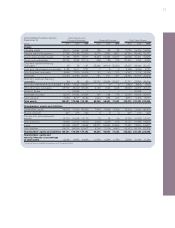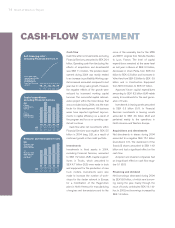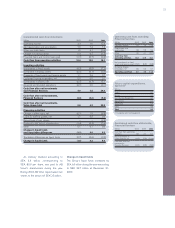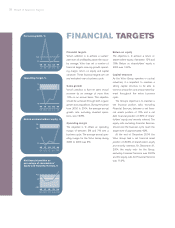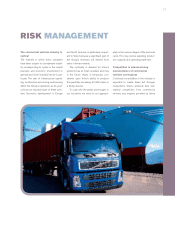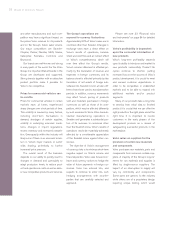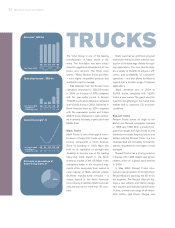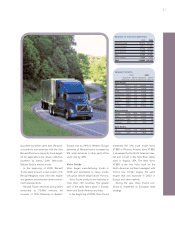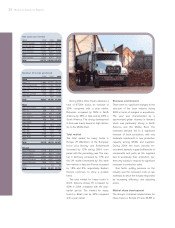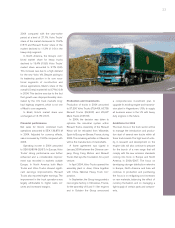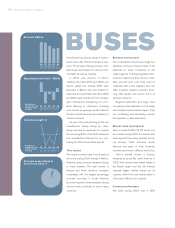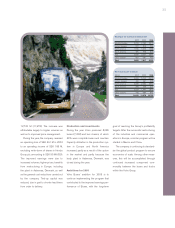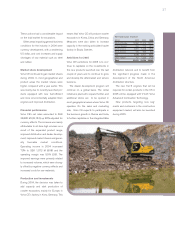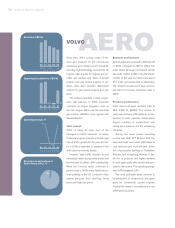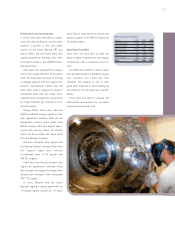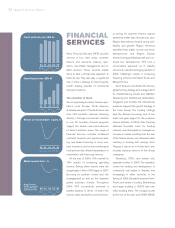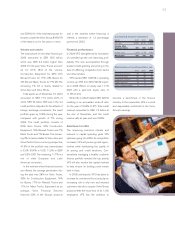Volvo 2004 Annual Report Download - page 25
Download and view the complete annual report
Please find page 25 of the 2004 Volvo annual report below. You can navigate through the pages in the report by either clicking on the pages listed below, or by using the keyword search tool below to find specific information within the annual report.
23
2004 compared with the year-earlier
period at a level of 27.1%. Volvo Trucks’
share of the market decreased to 15.2%
(15.7) and Renault Trucks’ share of the
market declined to 11.3% (11.4) in the
heavy-duty segment.
In North America, the Group’s com-
bined market share for heavy trucks
declined to 19.4% (19.8). Volvo Trucks’
market share amounted to 9.7% (9.4).
This increase was due to a high demand
for the new Volvo VN. Despite adding to
its leadership position in its core voca-
tional segments of construction and
refuse applications, Mack’s share of the
overall US retail market fell to 9.7% (10.4)
in 2004. This decline was due to the fact
that growth was disproportionately dom-
inated by the U.S. truck market’s long-
haul highway segment, which is not one
of Mack’s core segments.
In Brazil, Volvo’s market share was
unchanged at 13.1% (13.1).
Financial performance
Net sales for Volvo’s combined truck
operations amounted to SEK 136,879 M
in 2004. Adjusted for currency effects,
sales increased by 19.9% compared with
2003.
Operating income in 2004 amounted
to SEK 8,989 M (3,951). In Europe, Volvo
Trucks’ strong performance was further
enhanced and a considerable improve-
ment was recorded in markets outside
Europe. In North America both Mack
Trucks and Volvo Trucks showed signifi-
cant earnings improvements. Renault
Trucks also reported higher earnings. The
improvement in the truck operations was
largely attributable to higher sales vol-
umes and increased margins.
Production and investments
Production of trucks in 2004 amounted
to 97,300 Volvo Trucks (75,440), 60,755
Renault Trucks (52,400) and 25,637
Mack Trucks (18,519).
In 2004, the decision was taken to
optimize the industrial system within
Renault Trucks. Assembly of the Renault
Kerax will be relocated from Villaverde,
Spain to Bourg-en-Bresse, France, during
2006. The remaining activities in Villaverde
will be the manufacture of crankshafts.
A frame agreement was signed in
January 2004 between the Chinese com-
pany, Dong Feng Motors and Renault
Trucks that lays the foundation for a joint
venture.
In April 2004, Volvo Trucks opened the
assembly plant in Jinan, China together
with China National Heavy Truck Cor-
poration.
In September, the Group inaugurated a
new engine factory in Vénissieux, France,
for the assembly of 9 and 11 liter engines
and in October the Group announced
a comprehensive investment plan to
upgrade its existing engine and transmis-
sion plant in Hagerstown, USA, to supply
all business areas in the US with heavy
duty engines in the future.
Ambitions for 2005
The main focus in the truck sector will be
to manage the introduction and produc-
tion start of several new trucks within all
three truck brands. The high level of activ-
ity, in research and development on the
engine side, will also continue to prepare
for the launch of a new range that will
comply with the new emission standards
coming into force in Europe and North
America in 2006/2007. The focus on
developing stronger distribution networks
in Europe, North America and Asia will
continue. In production and purchasing,
the focus is on mitigating cost increases
on raw materials, balancing the effect of
currency fluctuation and on managing a
tight supply of certain parts and compon-
ents.


